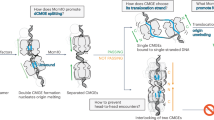Abstract
TRACHOMA agent, a member of the psittacosis–lymphogranuloma–trachoma (PLT) group, is an obligate parasite of the conjunctival cells in the human eye. Some strains, at least, retain their infectivity for the human eye after adaptation to growth and several passages in human cell cultures1,2. The infectious particles of trachoma agent are 0.3 µm in diameter and contain both DNA and RNA3. After entry into the host cell cytoplasm, the elementary bodies develop into large compact inclusion bodies containing glycogen4,5. These contain non-infectious structures in which the infectious elementary bodies are formed towards the end of the growth cycle. In this respect, the trachoma agent differs from the psittacosis agent. The latter forms diffuse cytoplasmic inclusions4, consisting of large reticulated forms which replicate by binary fission to produce elementary bodies similar to those of trachoma agent6. Both the large forms and the elementary bodies of psittacosis agent contain DNA and RNA7, and the large forms contain soluble RNA species8,9, ribosomal sub-units and ribosomes10. This investigation deals with the nature of the RNA species and the ribosomal subunits in the infectious elementary bodies of trachoma agent.
This is a preview of subscription content, access via your institution
Access options
Subscribe to this journal
Receive 51 print issues and online access
$199.00 per year
only $3.90 per issue
Buy this article
- Purchase on Springer Link
- Instant access to full article PDF
Prices may be subject to local taxes which are calculated during checkout
Similar content being viewed by others
References
Becker, Y., Mashiah, P., and Bernkopf, H., Bull. Res. Council, Israel, 10 E, 160 (1963).
Bernkopf, H., Treu, G., and Maythar, B., Arch. Ophthal., 71, 693 (1964).
Sarov, I., Becker, Y., and Bernkopf, H., Israel J. Med. Sci., 2, 661 (1966).
Gordon, F. B., and Quan, A. L., J. Infect. Dis., 115, 186 (1965).
Bernkopf, H., Mashiah, P., and Becker, Y., Ann. NY Acad. sci., 98, 62 (1962).
Moulder, J. W., Ann. Rev. Microbiol., 20, 107 (1966).
Tamura, A., and Higashi, N., Virology, 20, 596 (1963).
Tamura, A., and Iwanaga, M., J. Mol. Biol., 11, 97 (1965).
Tamura, A., Matsemoto, A., and Higashi, N., J. Bact., 93, 2003 (1967).
Tamura, A., J. Bacteriol., 93, 2009 (1967).
Bernkopf, H., Mashiah, P., and Maythar, B., Bull. Res. Council, Israel, 8E, 121 (1960).
Ossowski, L., Becker, Y., and Bernkopf, H., Israel J. Med. Sci., 1, 186 (1965).
Bernkopf, H., Amer. J. Ophthalmol., 63, 1206 (1967).
Gilbert, W., J. Mol. Biol., 6, 384 (1963).
Joklik, W. K., and Becker, Y., J. Mol. Biol., 13, 496 (1965).
Osawa, S., Progress in Nucleic Acid Research and Molecular Biology (edit. by Davison, J. N., and Cohn, W. E.), 4, 161 (Academic Press, 1965).
Nakada, D., and Kazi, A., Proc. US Nat. Acad. Sci., 57, 128 (1967).
Author information
Authors and Affiliations
Rights and permissions
About this article
Cite this article
SAROV, I., BECKER, Y. RNA in the Elementary Bodies of Trachoma Agent. Nature 217, 849–852 (1968). https://doi.org/10.1038/217849b0
Received:
Revised:
Issue Date:
DOI: https://doi.org/10.1038/217849b0
This article is cited by
-
Implications for persistent chlamydial infections of phagocyte-microorganism interplay
European Journal of Clinical Microbiology & Infectious Diseases (1991)
-
Chlamydia specific IgG and IgA antibodies in women with obstructive infertility as determined by immunoblotting and assays
European Journal of Epidemiology (1988)
-
Serum IgG and IgA antibodies specific for Chlamydia trachomatis in salpingitis patients as determined by the immunoperoxidase assay
European Journal of Epidemiology (1985)
-
Studies on the RNA of the mate-killer particles of paramecium
Heredity (1970)
-
Rifampicin—A New Antitrachoma Drug
Nature (1969)
Comments
By submitting a comment you agree to abide by our Terms and Community Guidelines. If you find something abusive or that does not comply with our terms or guidelines please flag it as inappropriate.



